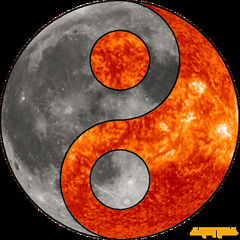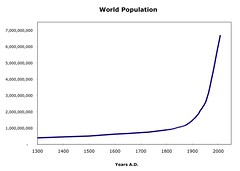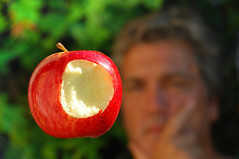An enterprise starts with the hope of a return on its investment. For a start-up, this is often envisioned on a spreadsheet, with the initial revenues being smaller than the initial expenses creating losses; however, the revenues increasing by some percentage and over time they outpace expenses to generate an attractive return on investment (ROI). While that is the typical story on paper; it's not reflected in the reality around us.
The World Population graph seems to show a linear growth like the one described in the above plan with some event happening in the late 1800's to suddenly make it change. Any idea what that historic event might have been?
If you haven't read the paper folding post, this may make a more sense if you do that. The graph shows natural, exponential growth. If we would change the time scale to end a century earlier, the curve would look the same, only the historic event would now appear to be in the late 1700's. End another century earlier, and the momentous event still moves back with the new scaling.
There was no event that changed the World population growth rate. Population growth is an example of growth from feedback and this graph is what that curve will always looks like. Small victories in the beginning, remaining small for far longer than our linear minds can imagine, then accumulating faster than linear thinking can grasp.
The two mistakes we can make are to believe the smaller growth rate is failure or to not accept the higher growth rate as success and invest in necessary infrastructure to keep the feedback going. It takes a faith that the returns will really happen to avoid either downfall. Of course this growth doesn't go on forever. There are always limits to growth; however, some are just in our linear minds.
During the Beatles's era, Maharishi Mahesh Yogi, who may have been the subject of their song Fool on the Hill, challenged his followers with the claim that if the square root of 1% of a population practices Transcendental Meditation (TM), crime in the area would decrease. In 1993, TM followers came to Washington DC during a record heat wave (which correlates to increased crime) to create such a critical number. Crime decreased for the period of the experiment. After its conclusion, it increased again.
This is not unique to TM. The story has been repeated in countless endeavors where fools have believed in continuing to repeat something powerful and gentle until the feedback effects can finally be observed; or until their return on investment is finally realized. We live in a faithful (systematic) universe; just not a linear one.
Image credit: mattlemmon
There should be no better investment than one you make in yourself. You are the Active Investment as well as the Active Investor. This blog is about what happens "inside" when you invest in yourself by having your own business. Sometimes it's fulfilling and sometimes it's frustrating. These postings are meant to be companions for the journey.
Tuesday, November 24, 2009
Monday, November 16, 2009
Power Produces Fractal Growth
 We can recognize those activities that create lasting values by their systematic characteristics of being repetitive, powerful, and gentle (RPG). This is characteristic of all of God's gifts to us from sunshine and rain to love and joy. These activities are the drivers that raise mountains, carve canyons, build successful organizations, and change societies. If we fill a lifetime with them, we fulfill our destiny and achieve peace.
We can recognize those activities that create lasting values by their systematic characteristics of being repetitive, powerful, and gentle (RPG). This is characteristic of all of God's gifts to us from sunshine and rain to love and joy. These activities are the drivers that raise mountains, carve canyons, build successful organizations, and change societies. If we fill a lifetime with them, we fulfill our destiny and achieve peace.Being powerful is the centerpiece. Exactly what does that mean? To start, the opposite of powerful is not weak, after all, the meek shall inherit the earth. No, the opposite of powerful is forceful.
Force creates change; but only as long as the forces are applied. Eventually they dissipate and the changes are lost. Force does not create lasting values. A deeper explanation of this can be found in Dr. David Hawkin's eye-opening book, Power vs Force.
Powerful activities are simple patterns that have universal application. They are those simple things each of us discover we can do well. Because of their universal applicability, the results of powerful activities build in a replicating, self-similar fashion. What begins to happen is fractal growth, represented by this week's illustration.
Fractals are the design of nature. Think about the shape of a cloud, a leaf, or a sea shell. They don't consist of circles, triangles, or polygons. Mathematicians have discovered these shapes are created when a simple function is endlessly repeated.
Our personal shapes are a good example. We are cellular. Our cells keep repeating (they are good at that) and our shape and capabilities form from that activity. We aren't assembled; we self-replicate and experience fractal growth.
A powerful set of activities is the heart of a good business plan. Is there something universally applicable incorporated into the business plan? Something that will work under alternative circumstances? Are those activities allowed to replicate and grow? If that's the plan, it's one to build lasting values.
Our personal schedules are no different. Am I repeating those powerful things to create success every day? What we are discussing here is both a financial strategy and a moral obligation.
This thinking then moves us to the importance of clear self-direction; and that is the secret of gentleness.
Image credit: SantaRosa OLD SKOOL
Labels:
Business plan,
business plans,
Consulting,
Fractal,
Motivation
Monday, November 9, 2009
The Tao of Active Investing
 The principles of building lasting value are timeless and universal. Chwan Tzu, an ancient Chinese philosopher, wrote the following centuries ago. It illustrates the impact of a repetitive, powerful, and gentle lifestyle as described in the Tao, the Chinese book about understanding and joining with natural forces. The story starts when Prince Hui complements his cook on his skills with a cleaver.
The principles of building lasting value are timeless and universal. Chwan Tzu, an ancient Chinese philosopher, wrote the following centuries ago. It illustrates the impact of a repetitive, powerful, and gentle lifestyle as described in the Tao, the Chinese book about understanding and joining with natural forces. The story starts when Prince Hui complements his cook on his skills with a cleaver."Well done!" cried the Prince; "yours is skill indeed."
"Sire," replied the cook, "I have always devoted myself to Tao. It is better than skill. When I first began to cut up bullocks, I saw before me simply whole bullocks. After three years' practice I saw no more whole animals. And now I work with my mind and not with my eye. When my senses bid me stop, but my mind urges me on, I fall back upon eternal principles. I follow such openings or cavities as there may be, according to the natural constitution of the animal. I do not attempt to cut through joints: still less through large bones.
"A good cook changes his chopper once a year -- because he cuts. An ordinary cook, once a month -- because he hacks. But I have had this chopper nineteen years, and although I have cut up many thousand bullocks, its edge is as if fresh from the whetstone. For at the joints there are always interstices, and the edge of a chopper being without thickness, it remains only to insert that which is without thickness into such an interstice. By these means the interstice will be enlarged, and the blade will find plenty of room. It is thus that I have kept my chopper for nineteen years as though fresh from the whetstone.
"Nevertheless, when I come upon a hard part where the blade meets with a difficulty, I am all caution. I fix my eye on it. I stay my hand, and gently apply my blade, until with a whach the part yields like earth crumbling to the ground. Then I take out my chopper, and stand up, and look around, and pause, until with an air of triumph I wipe my chopper and put it carefully away."
"Bravo!" cried the Prince. "From the words of this cook I have learned about the way of life."
A new active investing venture will always go through these 3 stages:
1) Seeing the whole and being confused by all its parts (Learning)
2) Understand the details and complexities (Managing)
3) Knowing exactly what to do from experience (Mastery)
Its comforting to know where we are at any given time and to be prepared to be happy there until we grow into the next stage.
Image credit: silentius
Labels:
active investment,
active investor,
business growth,
growth
Monday, November 2, 2009
The Problem of Original Sin
It's easy to believe and act on the power of good intention and co-creation; yet history and personal experience painfully demonstrate that life just isn't that easy. There is a restraining force that thwarts the co-creative powers of positive intentions and its been present as long as history has been recorded.
We find this force labeled "original sin" in Biblical doctrine. It's a favorite concept for those who wish to argue against Biblical teachings to attack; however, it does seem to explain what happens; so a second look at the mechanics of original sin is in order.
Cognitive scientists study the brain in an effort to understand the mind. Humans have this distinctive ability to be self-aware. We can observe and therefore can also encourage, love, criticize, or despise ourselves. It doesn't appear that other life forms can (or want) to do this. While all life has some form of intelligence, it just usually doesn't have the capability of self-awareness.
In the cognitive studies of the human brain, self-awareness appears to be in a special area of the human brain known as the prefrontal cortex. Unlike a mechanisms subject only to Newton's Laws, humans are not limited to a fixed reaction to an action. We use the prefrontal cortex and its capability of self-awareness to change our response.
Wonderful as self-awareness might be, the thousands of operational details required to maintain human life would simply over-whelm it. Never fear, a subconscious mind rises elegantly and efficiently to meet the need.While the prefrontal cortex is a small part of our total brain, the rest is busy operating all our life functions in an automatic fashion with any conscious direction.
A small portion of this subconscious intelligence is instinct. Most of our automated behaviors are learned. Researchers believe this larger area of our brain takes-in all it experiences as truth from birth until about the age of 6. While this system gives each succeeding generation the opportunity to receive updated lessons in living, the subconscious dutifully records with reason or judgment, often misinterpreting childhood experiences and forming false and/or destructive beliefs. These beliefs primarily come from our parents, who received them from their parents, who received them from generations of parents going back in time until the beliefs associated with original sin were started.
Defining sin is important. It was originally a term used in archery to mean "missing the mark." Original sin is the programming we receive from our ancestry that through our subconscious mental automation causes us to miss the potential we all were given. This definition is not meant to take away the use of the word sin to refer to missing out on God's grace; rather it includes that and more.
Neurologically, 95% of the brain is dedicated to the subconscious. While the remaining 5% can choose to be different, this doesn't happen easily. Corrective beliefs, in the form of new habits, are needed to re-program the subconscious. Forming those habits take the repetitive, powerful, and gentle actions this blog has discussed for Active Investors. Biblically, it is what the work of the Holy Spirit is all about for all of us.
Image Credit: petervanallen
We find this force labeled "original sin" in Biblical doctrine. It's a favorite concept for those who wish to argue against Biblical teachings to attack; however, it does seem to explain what happens; so a second look at the mechanics of original sin is in order.
Cognitive scientists study the brain in an effort to understand the mind. Humans have this distinctive ability to be self-aware. We can observe and therefore can also encourage, love, criticize, or despise ourselves. It doesn't appear that other life forms can (or want) to do this. While all life has some form of intelligence, it just usually doesn't have the capability of self-awareness.
In the cognitive studies of the human brain, self-awareness appears to be in a special area of the human brain known as the prefrontal cortex. Unlike a mechanisms subject only to Newton's Laws, humans are not limited to a fixed reaction to an action. We use the prefrontal cortex and its capability of self-awareness to change our response.
Wonderful as self-awareness might be, the thousands of operational details required to maintain human life would simply over-whelm it. Never fear, a subconscious mind rises elegantly and efficiently to meet the need.While the prefrontal cortex is a small part of our total brain, the rest is busy operating all our life functions in an automatic fashion with any conscious direction.
A small portion of this subconscious intelligence is instinct. Most of our automated behaviors are learned. Researchers believe this larger area of our brain takes-in all it experiences as truth from birth until about the age of 6. While this system gives each succeeding generation the opportunity to receive updated lessons in living, the subconscious dutifully records with reason or judgment, often misinterpreting childhood experiences and forming false and/or destructive beliefs. These beliefs primarily come from our parents, who received them from their parents, who received them from generations of parents going back in time until the beliefs associated with original sin were started.
Defining sin is important. It was originally a term used in archery to mean "missing the mark." Original sin is the programming we receive from our ancestry that through our subconscious mental automation causes us to miss the potential we all were given. This definition is not meant to take away the use of the word sin to refer to missing out on God's grace; rather it includes that and more.
Neurologically, 95% of the brain is dedicated to the subconscious. While the remaining 5% can choose to be different, this doesn't happen easily. Corrective beliefs, in the form of new habits, are needed to re-program the subconscious. Forming those habits take the repetitive, powerful, and gentle actions this blog has discussed for Active Investors. Biblically, it is what the work of the Holy Spirit is all about for all of us.
Image Credit: petervanallen
Labels:
Bible,
Forgiveness,
God,
identity,
Imagination,
love,
Motivation,
prayer,
problem solving,
Self-esteem
Subscribe to:
Posts (Atom)

![Reblog this post [with Zemanta]](http://img.zemanta.com/reblog_e.png?x-id=9ff68a50-a67e-4b57-9204-4eb49a40451d)
![Reblog this post [with Zemanta]](http://img.zemanta.com/reblog_e.png?x-id=4a892970-63ea-4571-bf50-1c25ff3cd8fd)
![Reblog this post [with Zemanta]](http://img.zemanta.com/reblog_e.png?x-id=9e7e4b36-f2b1-459d-a6f5-89c776339361)
